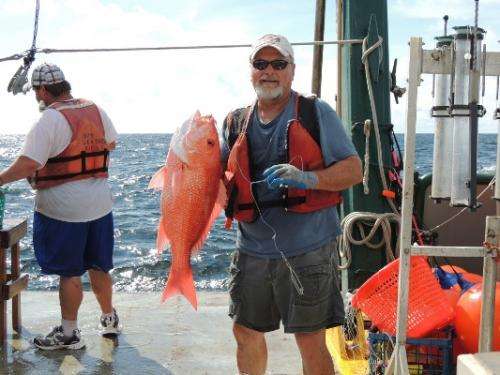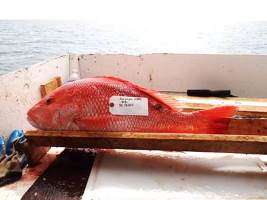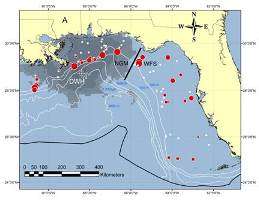USF Professor Steven Murawski began studying diseases in fin fishes after the 2010 Deepwater Horizon oil spill when Gulf of Mexico fishermen began reporting a surge in fish with visible lesions. Credit: C-Image.
Scientists studying the impact of the 2010 Deepwater Horizon oil spill on the health of fish in the Gulf of Mexico have found strong evidence that an outbreak of skin lesions and oil residue signatures discovered in fishes a year after the spill may be related to the catastrophe.
Publishing in Transactions of the American Fisheries Society, scientists from the University of South Florida (USF), the Florida Institute of Oceanography (FIO) and the Florida Fish and Wildlife Research Institute (FWRI) reported that there was strong chemical resemblance of the oil from the Deepwater Horizon blowout to that found in the fish livers and muscle of fishes sampled from the northern Gulf of Mexico. The researchers were also able to rule out pathogens and oceanographic conditions as potential causes for the lesions.
"The higher rates of skin lesions in 2011 vs. 2012 were not due to an outbreak of pathogens or abnormally low salinity, and thus the hypothesis that DWH was responsible for the higher rates of skin lesions remains viable," said researcher Steven Murawski, a professor of population dynamics and marine ecosystem analysis at USF's College of Marine Science.
Fishermen from the northern Gulf had reported abnormal looking fish beginning in the winter of 2010-2011, and the scientists involved mounted scientific surveys beginning in 2011 to evaluate the severity lesions in red snapper and other species.
A red snapper adult captured west of the Deepwater Horizon oil spill site with an eruptive skin lesion near the tail. Credit: Steven Murawski.
A team of scientists and graduate students led by Murawski along with USF marine biologists Ernst Peebles, Florida Institute of Oceanography Director William Hogarth and Florida Wildlife Research Institute chief of marine fisheries research Luiz Barbeiri noted: "The incidence of skin lesions in 2011 sampling was most frequent in some bottom-dwelling species along the continental shelf edge north of the Deepwater Horizon site.
"Surveys revealed that by 2012 the overall lesion frequency had declined 53 percent, with the severity of lesions also declining."
The scientists analyzed a class of oil compounds called polycyclic aromatic hydrocarbons, or PAHs, which tend to be the most toxic and in some cases carcinogenic parts of crude oil. Red snapper found near the site had elevated PAH levels consistent with similar results from polluted West Coast harbors. Their findings showed a strong resemblance of the oil found in fish liver and muscle to the oil released by the Deepwater Horizon blowout, and that PAH residues declined in snapper bile between 2011 and 2012 by up to 50 percent, indicating that the fish were exposed to an episodic pollution event.
Prevalence of skin lesions at sampling sites in 2011: White dots indicate 0 percent skin lesions, red circles are proportional in size to the percent frequency of lesions. DWH is the site of the Deepwater Horizon oil spill, and gray shading is the surface extent of oil as seen from aircraft and satellites. Credit: Steven Murawski.
Professor Murawski noted: "This study found a strong resemblance of PAH levels in fish to oil emanating from the DWH event, as opposed to other hydrocarbon sources in the Gulf."
Work by the group of scientists continues in order to better understand the implications of the exposure to Deepwater Horizon oil on the growth, reproduction and survival of fishes that were affected by the spill.
More information: The complete article is available online: www.tandfonline.com/toc/utaf20/current
Journal information: Transactions of the American Fisheries Society
Provided by University of South Florida
























